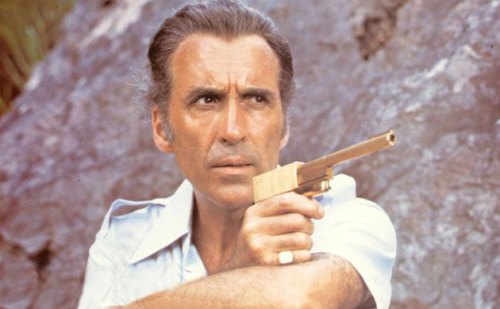I know I keep harping on about how preoccupied the Bond franchise is with its own franchise-isity but it is difficult to avoid this conclusion after taking in The Man With the Golden Gun (1974). This oft maligned and parodied film is obsessed with disfigurement. And what does disfigurement imply but some sort of standard or norm that is healthier or superior to those that fall short or fail to develop properly? TMWtGG’s relationship with disfigurement is a bit more complicated than all that and thankfully so. In fact, it might even be staking the claim that the disfigured, while ultimately doomed, can be re-purposed and made more interesting, made even more necessary than the standard. A fascinating if not self-serving argument for the ninth cinematic installment of 007.
First a catalog of the many strange deformities on display here. I’m sure there are many more where this came from:
01. The titular character, one Francisco Scaramanga, has a supernumerary nipple. Oh, and he just so happened to have been raised in traveling circus which is nothing more than a collection of people and things that are strange or exceptional, i.e far from the norm. Scaramanga was also a trick shot artist, so his move into the assassination game is actually a programmatic course correction. Instead of using guns against their own design and for, say, entertainment, he is now employing them as the weapons they were developed to be.
02. Scaramanga’s servant Nick-Nack is a dwarf.
03. Scaramanga’s Golden Gun has a unique caliber found nowhere else. In other words even the man’s gun is deformed. To say nothing of the fact that while it could certainly be argued a great many folks use gold as a weapon to enslave and ultimately kill other people, Scaramanga literally shoots people with bullets made of gold. Yet another misappropriation in a film full of them.
04. Nick-Nack hires assassins to come try and kill his boss. Yet he knows they will never succeed. So the dwarf is basically hiring assassins not to kill but to die.
05. And they’ll be killed in Scaramanga’s hall of mirrors which feature hallways with false perspectives and other tilted frames. Everything is crooked and off-center like some German Expressionist set.
06. Speaking of slanted walls, the MI6 base Bond visits inside the wreck of the RMS Queen Elizabeth has been retrofitted into a space that is tilted about 45 degrees to the side. Walls, ceilings and doors all lean to the side and folks are constantly ducking and turning this way and that.
07. The Belly dancer Saida wears the mashed remnant of the bullet that killed her lover as a good luck charm.
08. She leads Bond to the expert gunsmith Lazar (who fashions the odd caliber golden ammo) who demonstrates a rifle he is working on that can be fired by a man without fingers.
09. A dojo full of martial arts students are defeated by what we were thought to be two innocent little girls.
10. Bond invites his fellow agent Miss Goodnight over to have sex but ultimately shoves her in a closet so that he can have sex with Andrea Anders, Scaramanga’s mistress. Who just so happened to send Bond a golden bullet with his number on it that made him think he was under threat of assassination. In truth she sent it to get Bond to kill Scaramanga.
11. Scaramanga’s car can fly.
And on and on, really.
So the film is both consciously aware that it must re-purpose the tired Bond tropes if it wants to succeed (as art, etc) on one hand and yet a equal amount of pressure is being applied from producers who want the standard formula to stay uncompromised, because it has proven to be a successful money maker. What is curious is that Scaramanga and his crew seem to align themselves with the former position while James Bond himself is the incarnation of the latter. So which is more successful?
This is pretty much the Christopher Lee show. Every time the actor is onscreen as Scaramanga there are few reasons to pay attention to anyone else. He is smart, charismatic, self-aware and deliberate. Everything James Bond himself should be. Until… well, until the duel late in the film where he lets his (and the film’s) obsession with disfigurement get the best of him. Meanwhile Roger Moore is in complete snooze mode. I enjoyed him in Live and Let Die, but here he is empty space, a non-character. His fade is accelerated by the inclusion of a pair of non-descript Bond girls, one who is destined to be killed the other of which spends most of the film either trapped in small spaces (closets, the trunks of cars, bikinis) or accidentally pressing buttons with her ass.
So in the end tMWtGG is something of a tease. It promises delivery from the staid and stale yet balks at the last minute, assuring us that nothing was every really in danger of changing at all. This combined with a truly awful theme song and the ham handed return of the idiotic Louisiana Sheriff from L&LD keep tMWtGG merely entertaining when it could have been pretty damn transcendent.
Bond Grade (out of 007): 003



Leave a comment